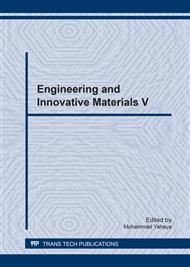[1]
R.C. Rice, J.L. Jackson, J. Bakuckas, S. Thompson, Metallic Materials Properties Development and Standardization (MMPDS) Handbook, NTIS Virginia Scientific Report (2003).
Google Scholar
[2]
S. Kalpakjian, Manufacturing Engineering and Technology, 3rd Edition. Addison-Wesley Publishing Co. (1995).
Google Scholar
[3]
S.G. Irizalp, N. Saklakoglu, High strength and high ductility behavior of 6061-T6 alloy after laser shock processing, Optics and Lasers in Engineering Vol. 77 (2016), p.183.
DOI: 10.1016/j.optlaseng.2015.08.004
Google Scholar
[4]
A. Salimianrizi, E. Foroozmehr, M. Badrossamay, H. Farrokhpour, Effect of laser shock peening on surface properties and residual stress of Al6061-T6, Optics and Lasers in Engineering Vol. 77 (2016), p.112.
DOI: 10.1016/j.optlaseng.2015.08.001
Google Scholar
[5]
T. Shikama, Y. Takahashi, L. Zeng, S. Yoshihara, T. Aiura, K. Higashida, H, Noguchi. Distinct fatigue crack propagation limit of new precipitation-hardened aluminum alloy, Scripta Materialia Vol. 67 (2012), p.49.
DOI: 10.1016/j.scriptamat.2012.03.018
Google Scholar
[6]
L. Zeng, T. Shikama, T. Yoshimasa, S. Yoshihara, T. Aiura, H. Noguchi, Fatigue limit of new precipitation-hardened aluminum alloy with distinct fatigue crack propagation limit, International Journal of Fatigue Vol. 44 (2012), p.32.
DOI: 10.1016/j.ijfatigue.2012.06.001
Google Scholar
[7]
P. Chowdhury, H. Sehitoglu, Mechanisms of fatigue crack growth – a critical digest of theoretical developments, Fatigue Fract. Engng. Mater. Struct. Vol. 39 (2016), p.652.
DOI: 10.1111/ffe.12392
Google Scholar
[8]
A.J. McEvily. Metal failures: Mechanism, Analysis, Prevention, 2nd Edition. Wiley. (2013).
Google Scholar
[9]
F. Wang, D. Qiu, Z-L. Liu, J.A. Taylor, M.A. Easton, M-X, Zhang, The grain refinement mechanism of cast aluminum by zirconium, Acta Materialia Vol. 61 (2013), p.5636.
DOI: 10.1016/j.actamat.2013.05.044
Google Scholar
[10]
N. Anjabin, A.K. Taheri, H.S. Kim, Simulation and experimental analyses of dynamic strain aging of a supersaturated age hardenable aluminum alloy, Material Science & Engineering A Vol. 585 (2013), p.165.
DOI: 10.1016/j.msea.2013.07.038
Google Scholar
[11]
S. Zhao, C. Meng, F. Mao, W. Hu, G. Gottstein, Influence of severe plastic deformation on dynamic strain aging of ultrafine grained Al-Mg alloys, Acta Materialia Vol. 76 (2014), p.54.
DOI: 10.1016/j.actamat.2014.05.004
Google Scholar
[12]
M. Valsan, D.H. Sastry, K.B.S. Rao, S.L. Mannan, Effect of strain rate on the high-temperature low-cycle fatigue properties of a nimonic PE-16 superalloy, Metallurgical and Materials Transaction A Vol. 25A (1994), p.159.
DOI: 10.1007/bf02646684
Google Scholar
[13]
J.C. Newman, W. Elber, Mechanics of Fatigue Crack Closure, ASTM STP 982, ASTM Philadelphia. (1988).
Google Scholar


